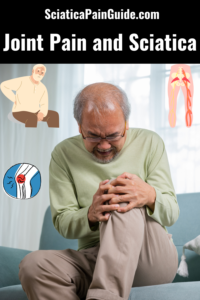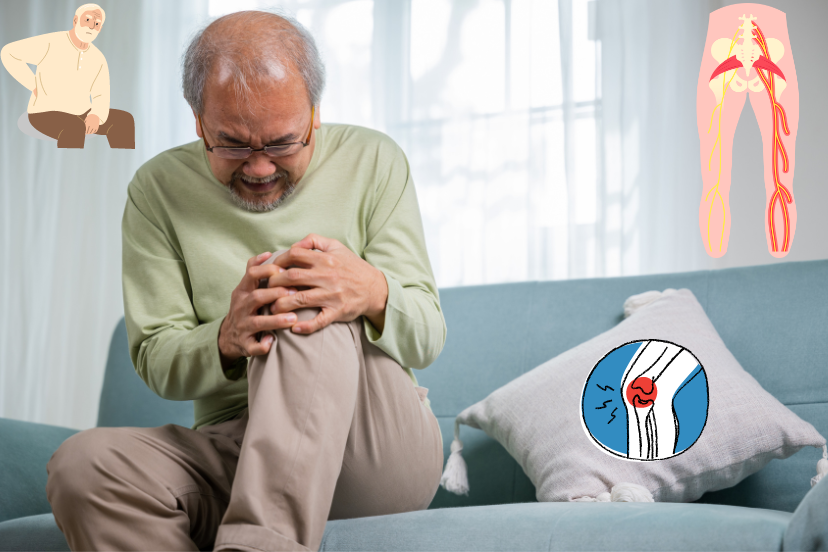Joint Pain and Sciatica
Discover effective strategies to manage joint pain and sciatica. Learn about causes, symptoms, prevention, and treatment options for optimal relief. As someone who has dealt with sciatica and its accompanying joint pain, I understand the challenges it can bring to everyday life. In this article, I’ll delve into the intricacies of joint pain and sciatica, discussing their causes, symptoms, and effective management strategies.
Understanding Joint Pain
Joint pain, affecting areas like knees and hips, results from inflammation, overuse, or conditions like arthritis. Symptoms often include swelling, stiffness, and limited mobility, hindering daily activities. It may stem from age-related wear and tear or autoimmune diseases. Management involves lifestyle changes, exercise, and medication. Understanding its causes and symptoms is crucial for effective treatment and improving overall quality of life.
Causes of Joint Pain
Joint pain can arise from various factors, such as inflammation due to conditions like arthritis, overuse from repetitive movements, or injury. Age-related wear and tear on cartilage and bones can also contribute. Autoimmune diseases targeting joints, like rheumatoid arthritis, may trigger inflammation. Additionally, genetic predispositions and lifestyle factors such as obesity can exacerbate joint discomfort. Understanding these causes is essential for developing targeted treatment plans to alleviate pain and improve joint health.
Symptoms of Joint Pain
Symptoms of joint pain encompass a range of sensations, including swelling, stiffness, and tenderness in affected areas. Individuals may experience limited range of motion and difficulty performing everyday tasks. Joint pain can manifest as sharp or dull discomfort, depending on its underlying cause. In severe cases, joints may appear red and swollen, accompanied by warmth. Understanding and recognizing these symptoms promptly enables individuals to seek appropriate medical attention and implement strategies for pain management and relief.
Understanding Sciatica
Sciatica involves nerve pain along the sciatic nerve, originating from the lower back and radiating down one or both legs. It’s typically caused by compression or irritation of the nerve roots, often due to a herniated disc or spinal stenosis. Symptoms include sharp pain, tingling, and numbness. Understanding sciatica’s origins and symptoms is crucial for effective management and relief of discomfort.
Causes of Sciatica
Sciatica primarily results from compression or irritation of the sciatic nerve, often due to a herniated disc, spinal stenosis, or muscle spasms. In some cases, pressure on the nerve can stem from a bone spur or tumor. Pregnancy-related changes, such as added weight and hormonal shifts, may also contribute to sciatic nerve compression. Understanding these underlying causes is vital for determining appropriate treatment strategies and alleviating symptoms effectively.
Symptoms of Sciatica
Symptoms of sciatica typically include shooting pain that radiates from the lower back down one leg, often accompanied by numbness, tingling, or weakness. The pain may worsen with movement, such as standing or sitting for extended periods. Individuals may also experience difficulty walking or standing up straight. Understanding these symptoms is crucial for distinguishing sciatica from other types of back pain and seeking appropriate treatment.
Sciatica, Joint Pain Or Piriformis Problems
Relationship between Joint Pain and Sciatica
While joint pain and sciatica are distinct conditions, they can coexist and sometimes exacerbate each other. Sciatica, stemming from nerve compression in the lower back, can cause pain that radiates down the leg, mimicking joint pain. Conversely, joint pain, particularly in the hips or pelvis, can contribute to sciatic nerve irritation. Understanding the interplay between these conditions is essential for comprehensive management and targeted treatment approaches to alleviate discomfort effectively.
Prevention of Joint Pain and Sciatica
Preventing joint pain and sciatica involves adopting proactive measures to maintain overall musculoskeletal health. Lifestyle changes such as maintaining good posture, avoiding prolonged sitting, and incorporating regular exercise routines can reduce the risk of joint discomfort and sciatic nerve compression. Additionally, maintaining a healthy weight through balanced nutrition and staying hydrated can alleviate strain on the joints. Implementing these preventive strategies can help individuals mitigate the onset and severity of joint pain and sciatica.
Lifestyle Changes
Implementing lifestyle changes is pivotal in mitigating joint pain and preventing sciatica. Maintaining proper posture during activities, avoiding prolonged sitting or standing, and integrating regular breaks to stretch can alleviate strain on the musculoskeletal system. Engaging in low-impact exercises like swimming, tai chi, or yoga strengthens muscles, supporting joint function and reducing the risk of sciatic nerve compression. Moreover, maintaining a healthy weight through a balanced diet and staying hydrated promotes overall joint health, minimizing discomfort and enhancing mobility.
Exercise and Stretching
Engaging in regular exercise routines that focus on strengthening the muscles supporting the joints and improving flexibility can reduce the risk of joint pain and alleviate sciatic nerve compression.
Maintaining Healthy Weight
Maintaining a healthy weight through proper diet and exercise can alleviate excess strain on the joints, reducing the likelihood of developing joint pain and sciatica.
Managing Joint Pain and Sciatica
While prevention is key, effectively managing joint pain and sciatica is essential for individuals already experiencing symptoms.
Medications
Over-the-counter pain relievers, nonsteroidal anti-inflammatory drugs (NSAIDs), and muscle relaxants can provide temporary relief from joint pain and sciatica. However, it’s essential to consult a healthcare professional before starting any medication regimen.
Physical Therapy
Physical therapy techniques such as stretches, exercises, and manual therapy can help improve joint mobility, reduce inflammation, and alleviate sciatic nerve compression.
Alternative Therapies
Alternative therapies such as acupuncture, chiropractic care, and yoga may offer additional relief for individuals with joint pain and sciatica. However, results may vary, so it’s crucial to explore these options under the guidance of a qualified practitioner.
Joint Pain and Sciatica – Conclusion
In conclusion, understanding joint pain and sciatica is crucial for effective management and prevention strategies. Both conditions can significantly impact daily life, but with proactive measures and appropriate treatment, individuals can find relief and improve their overall well-being. By adopting lifestyle changes, engaging in regular exercise, and maintaining a healthy weight, the risk of joint pain and sciatica can be minimized. Additionally, seeking timely medical intervention and exploring alternative therapies can provide further support in managing symptoms and enhancing quality of life. With dedication and comprehensive care, individuals can regain control over their musculoskeletal health and enjoy a pain-free lifestyle.
Please note that this article should not replace professional medical advice. Consult a healthcare professional for an accurate diagnosis and tailored treatment plan.
FAQs Related to Joint Pain and Sciatica
Is sciatica the same as regular back pain?
No, sciatica specifically refers to nerve pain radiating along the sciatic nerve, often originating in the lower back and extending down one or both legs. Regular back pain can have various causes, while sciatica involves specific nerve compression.
Can joint pain and sciatica be cured completely?
While there’s no guaranteed cure, many individuals find significant relief through a combination of lifestyle changes, treatment modalities, and ongoing management strategies. Effective management can help minimize symptoms and improve quality of life, although complete eradication of joint pain and sciatica may not always be achievable.
Are there specific exercises to avoid with sciatica?
Yes, certain high-impact activities or movements that exacerbate sciatic nerve compression, such as heavy lifting or sudden twisting motions, should be avoided. It’s best to consult with a healthcare professional or physical therapist for personalized exercise recommendations tailored to individual needs and limitations.
How long does it take to recover from a sciatic nerve flare-up?
Recovery time from a sciatic nerve flare-up varies depending on severity and individual factors. With proper treatment and self-care measures, many experience improvement within weeks to months. However, some cases may require longer recovery periods or ongoing management to alleviate symptoms and prevent future flare-ups.
What are some ergonomic tips for reducing joint pain and sciatica at work?
To reduce the pain at work, ensure proper ergonomic setup by adjusting workstation height, using supportive chairs, and incorporating standing desks. Take regular breaks to stretch and move, practice proper lifting techniques, and maintain good posture. Implementing these ergonomic tips can help alleviate discomfort and prevent work-related musculoskeletal issues.





